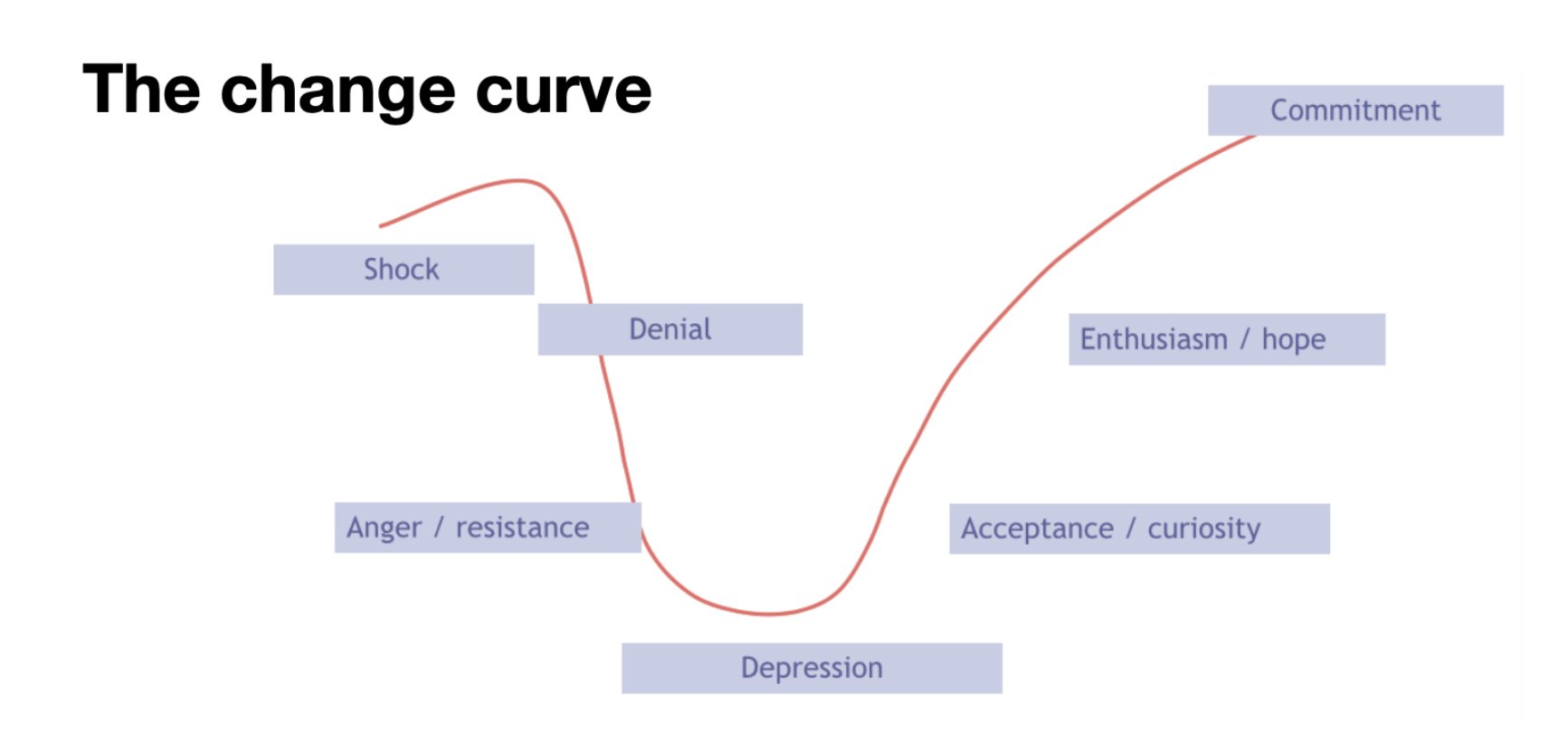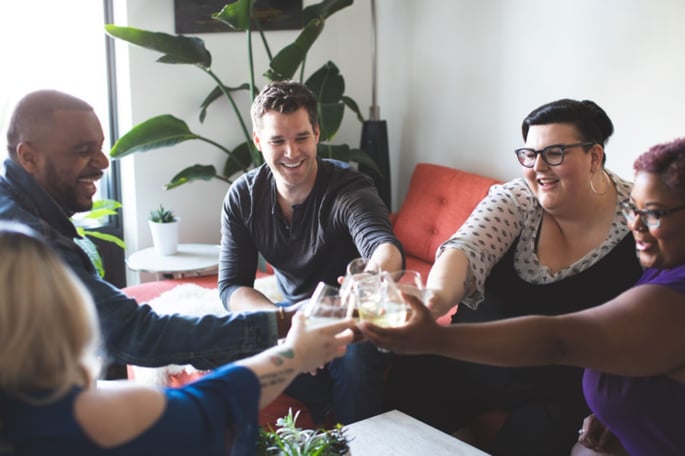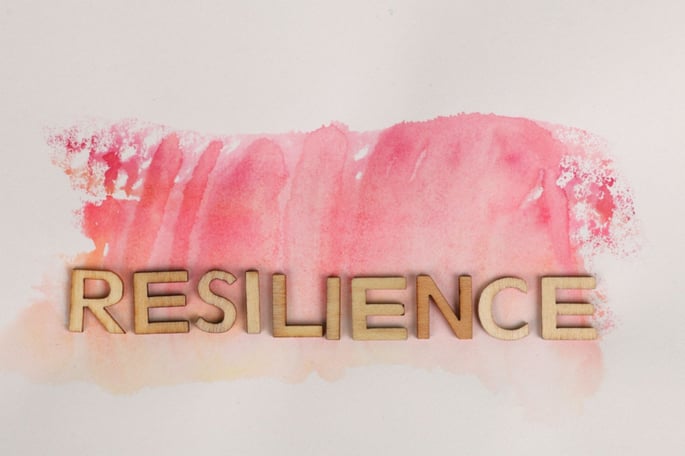Anti-racism is a practice, not a destination.
8-minute read
At LifeLabs, we have the incredible opportunity to help our clients make small changes that lead to big impact. This has never been more true as we (and our clients) respond to the uprising catalyzed by The Movement for Black Lives. This moment has required all of us to listen deeper, share more, and be open to changing our long-held assumptions and habits.
Change can be emotional, in fact, the brain processes the experience of change through a series of emotional stages captured helpfully by the Kubler-Ross & Kessler Change Curve. Not everyone experiences every emotion on the curve the same, but for anyone set on changing their mindset from “not racist” to practicing anti-racism, emotions are likely to be intense. The change curve can be a helpful tool for navigating intense feelings and as a source for go-to interventions that can help you work through to the next stage.

One key part of applying an anti-racist lens towards personal development is recognizing that organizational psychology historically elevates cisgender white voices. Important, too, is that I am a cisgender Gay white American male, which informs how I make sense of these ideas. At LifeLabs, we all are working to lift up Black and Brown perspectives in the psychology space while also using the tools we have easily available to make sense of our moment.
It’s also important to remember that anti-racism is a practice, not a destination. At LifeLabs, we experience the change curve of anti-racism as non-linear. We feel hope, then anger, then depression, then curiosity all in one conversation.
You may get feedback along the way that may be hard to hear. You may have insights that really challenge who you thought you were. This is the work.
Shock
Example thoughts: “How is this still happening in 2020?” and/or “I thought we were past this!”
The Intervention: Get Comfortable Getting Uncomfortable
The brain likes to stay comfy the same way you want to be cuddled up with a good book on a rainy day. For many of us, the stories of racism have been a shock to our systems.
To practice getting through your shock, try staying with the discomfort longer than you normally would. Maybe that means spending 10 more minutes watching a video that unsettles you, reading an article that you wouldn’t normally read, or listening to a story you’re hesitant to hear.
- Additional resource to practice the 10% rule:
- Watch documentaries like 13th and Who’s Streets? on Netflix.
- Read that article a friend posted that you’d normally skip over for being “too upsetting.”
- Listen to (and believe) your Black friends and coworkers when they tell you racist things are happening in their world.
Denial
Example thoughts: “I don’t see color.”; “I have black friends, I can’t be racist.”; and/or “Someone else will deal with this problem.”
The Intervention: Practice Filling in the Gaps
Our brain loves to reinforce our previously held beliefs. Confirmation bias makes it easy to disbelieve what’s happening in front of us. The brain is an expert in seeing (or not seeing) whatever data will mean not re-appraising previous conclusions.
To open the brain up to gathering new data, an anti-racist practitioner in the denial stage needs to actively seek out data and narratives that fill in the gaps between old beliefs and new paradigms of understanding.
- Additional resources for Filling in the Gaps:
- Read the following
- How to be an Anti-Racist By Ibram X. Kendi
- Biased: Uncovering the Hidden Prejudice That Shapes What We See, Think, and Do by Psychologist Jennifer L. Eberhardt
- So You Want to Talk About Race by Ijeoma Olua
- Read the following
Anger/Resistance
Example thoughts - “Why do people need to protest?!”; “We need to keep our criminal justice systems to stay the same”; “Why are they saying white people? I’m not racist!”; and/or “My ancestors were oppressed too!”
The Intervention - Agree Before Disagree
Researchers observe a phenomenon known as the 'backfire effect' when we're confronted with contradictory evidence. Rather than have our minds changed during an argument (for example, when someone opposes our belief that protesting isn't effective), we can double down on our convictions, leaving the argument more entrenched in our viewpoint. Simple logic dictates that if two or more egos in a conversation are experiencing the backfire effect, everyone leaves just feeling upset and superior.
The good news is that anger and resistance tend to occur when deep values are coming to the surface of the conversation. To avoid giving into the anger, lean into the deep values that you share with your “opponent.” For example, on the issue of defunding police, perhaps the common ground is that you both want all people to feel safe in this world. Finding commonalities between your position and the “opposition” builds consensus and honors the complexities of the situation.
- Tips on practicing Agree Before Disagree
- Ask yourself a “needs-forward” question: e.g., “What am I afraid of losing?” or “What’s the core value that I’m trying to protect?”
- Ask yourself a “next-step question”: e.g., “What’s a tangible solution that would be a win-win for what everyone wants?”
- Ask yourself a “scaling question”: e.g., “Scale of 1-10, how open am I to this change? And what would need to be true to increase that score by 1 point?”
Depression
Example thoughts - “Nothing will ever change, people won’t listen.” and/or “It’s all just so overwhelming and I can’t do it all by myself.”
The Intervention - Seek early and visible wins
The practice of anti-racism can look exhausting, almost like a never-ending climb up Mount Everest. However, any mountain climber will tell you to never judge your progress by looking up, but rather to look back to see how far you’ve come. The brain loves progress; research shows that our brain produces a “hit” of dopamine for the body every time we perceive progress. To get those dopamine hits, design your process to have some early and visible “wins.”
Perhaps you read 20 pages of one of the recommended books, or finished watching one of the documentaries. These dopamine hits will be crucial in getting you through the depression stage.
- Ideas on how to Design Early and Visible wins
- Join/create a book club centered around working through anti-racism.
- Create a weekly “most important things” list of three things to do every week towards your work on anti-racism.
- Read the news and look for signs of change.
Acceptance/Curiosity
Example thoughts - “Ok, where do I start?” and/or “I’m ready to learn and do the work.”
The Intervention - Change The Cycle of Socialization
Researchers call the ecosystem of perspectives and voices we engage with regularly our ‘cycle of socialization.’ Our cycles are a combination of all of the news, social media, books, media, and conversations we have.
We can broaden our horizons by shaping what voices we hear from on a regular basis. This might mean following different people on social media, listening to different podcasts, and consuming art from BIPOC creators.
It might also mean conducting listening tours. Listening tours are about getting real insights from the people in your life about how to make the changes you want to make, and getting feedback from them as you do. This means asking yourself and others questions like “How have I supported racist structures and practices?” and “What can I do differently next time to support you?”
- Ideas on how to Change Your Cycle of Socialization
- Change the people you follow on social media platforms - Here are some activists, writers, and psychologists that I follow: Brittany Packnett Cunningham, Rachel Cargle, Holiday Phillips, Ashlee Marie Preston, Avery Francis, and Patrisse Cullors-Brignac
- Add a new podcast to your repertoire. Personal favorites: “Code Switch,” “Pod Save the People,” and “1619”
- I love science fiction. A great author to look into is N.K. Jemisin who wrote the Broken Earth Series.
Enthusiasm/Hope
Example thoughts - “Wow, this feels really good!” and “I’m actually noticing a difference in how I show up.”
The Intervention - Simplify the plan
In order for the brain to make anything a habit, it needs repetition. Repetition becomes even easier the less we have to think about the change. Try folding your anti-racism practice into things you are already doing or are already familiar with.
- Resources on where you can Simplify the Plan
- Online Shopping - Create a bookmark of black owned businesses to make it easier to support them.
- Set up monthly donations for organizations like Black Lives Matter or the NAACP Legal Defense Fund.
- Attend a protest with a friend who’s gone before and can show you the ropes of good ally etiquette.
Commitment
Example thoughts - “I commit to the practice of being anti-racist.”
The Intervention - Micro-interventions + Staying Ready for Change
Anti-racism is now a part of your daily practice. Now the real work begins.
The best way to practice the work is by taking action when you see micro or macro-aggressions in your world. This is especially true for white folks intervening with other white folks, as the brain is more open to change when the person intervening looks like the aggressor. Having these conversations doesn’t always have to be hard.
“Staying ready for change” isn’t a stage on the change curve, but a recognition that we will all mess up. You will say or do the wrong thing. When you do, do not try to explain or defend what you did. Instead, look inward and seeing where more work may be necessary.
At LifeLabs, we’re committing to doing our part in anti-racism. We’re actively updating what research we use in our workshops to include more Black and Brown voices, training companies on how to be more inclusive, and having regular conversations about how we can internally and externally practice anti-racism.
Where will you start on your journey towards practicing anti-racism?


